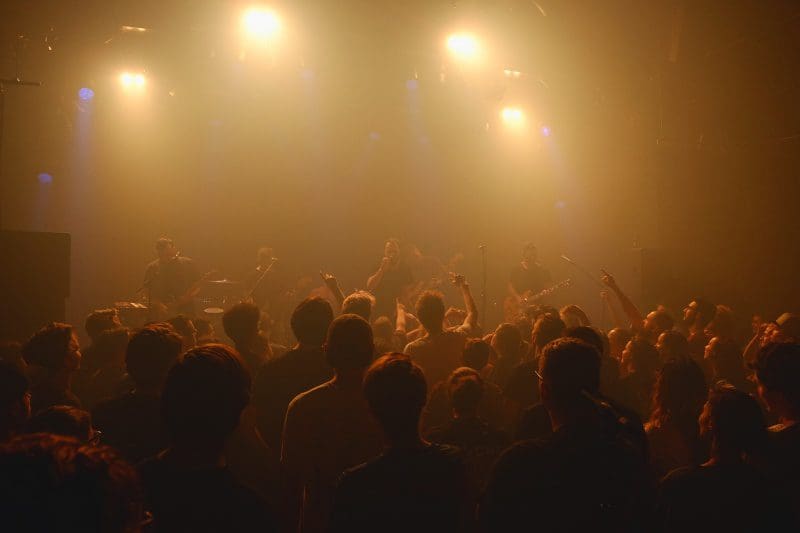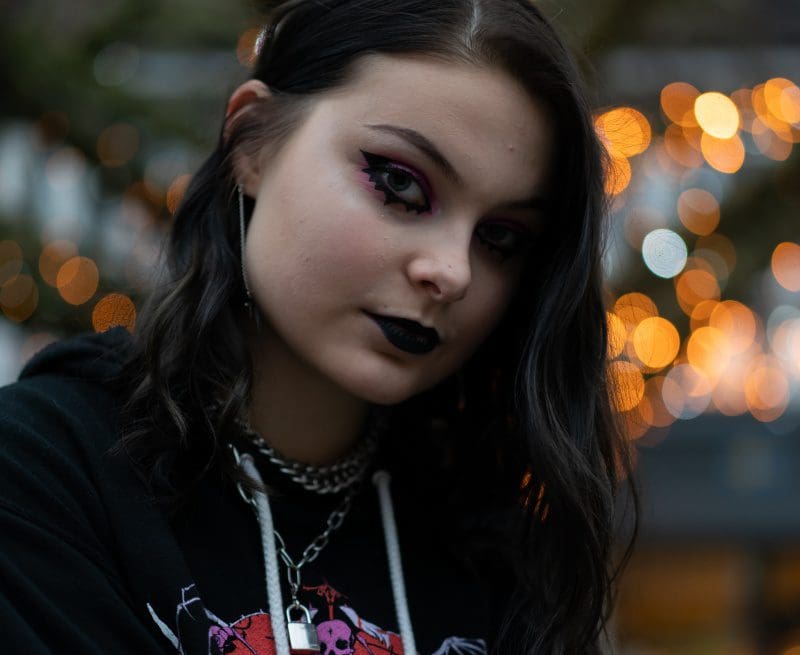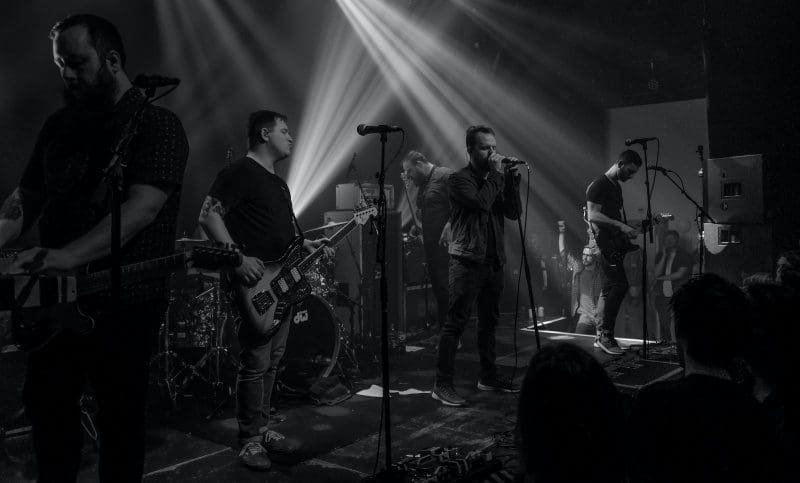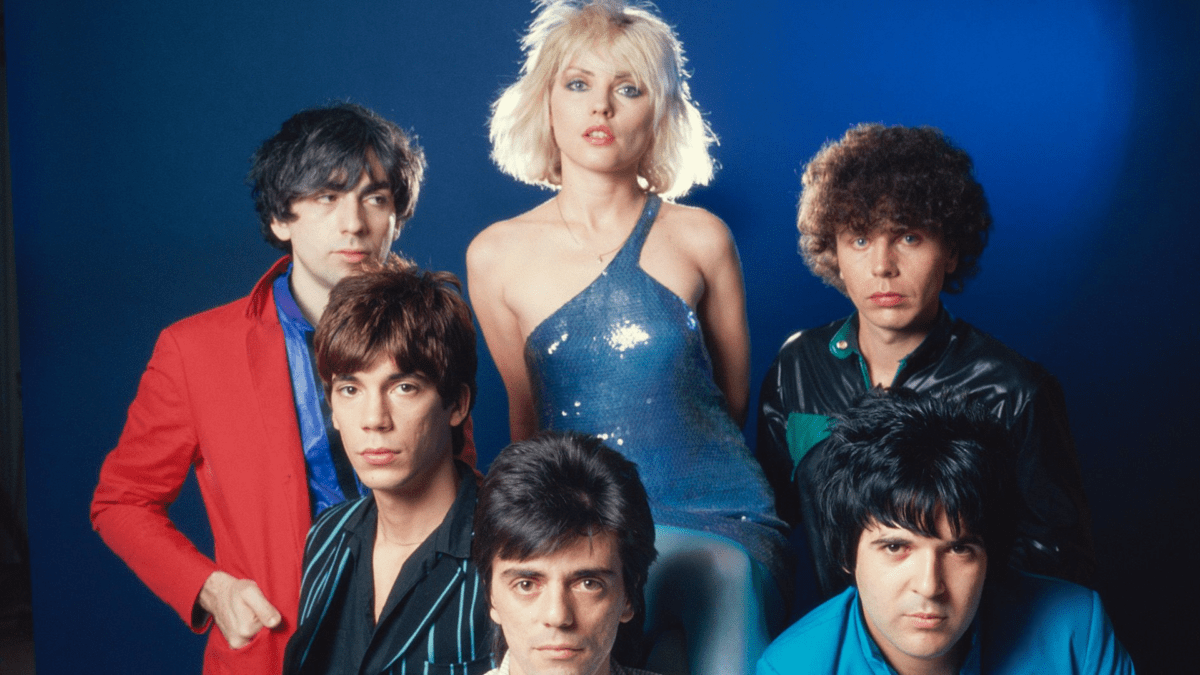
First emerging in the mid-1980s, emocore’s intensely emotional and relatable themes have resonated with listeners. Over the years, the genre has grown beyond just music, incorporating fashion trends, behaviour, and ways of living. But what exactly is emocore?
In this article, we’ll explore the intricacies of the emo genre. We’ll consider the characteristics of emo music, explore its origins and evolution, and discover a selection of essential emocore albums. Whether you’re a devoted fan or a curious newcomer, this exploration of emocore will provide a comprehensive understanding of this passionate and often misunderstood musical genre.
What Is Emocore? A Definition
At its core, emocore, normally referred to simply as emo, is a genre that originated from punk rock in the mid-1980s. It takes particular musical inspiration from the wide-reaching post-hardcore scene, with influence from standout artists such as Fugazi and Quicksand. The term “emocore” itself is a portmanteau of ’emotional hardcore’, which aptly describes the music’s deeply emotional lyrics and aggressive, high-energy sound that is characteristic of hardcore punk.
Emo bands typically make use of expressive, often confessional, lyrics that delve into topics such as failed romance, mental health, personal trials, and existential angst. This stark openness and emotional vulnerability sets emocore apart from other genres and have been key to its appeal among listeners, who find solace and understanding in its lyrics.
The History and Evolution of Emocore Music

Emo music has a rich history, evolving significantly through the decades. Its roots trace back to Washington D.C.’s punk scene in the mid-80s, with bands like Rites of Spring and Embrace pioneering the genre. They infused punk rock’s raw energy with more introspective and personal lyrics, giving birth to a new musical movement.
The 1990s saw the emergence of a second wave of emocore, with bands like Sunny Day Real Estate and Jawbreaker gaining popularity. In this period, emo became more melodic, incorporating elements of indie rock. By the 2000s, the genre had infiltrated mainstream consciousness, with bands like My Chemical Romance, Fall Out Boy, and Panic! At the Disco achieving commercial success.
The Emotional Depth of Emocore Lyrics
Emo lyrics are known for their emotional depth and introspective nature. They delve into the human condition, exploring themes of love, loss, depression, and angst. This raw emotional honesty is what sets emo apart, resonating with so many listeners.
Emocore lyrics often serve as a form of catharsis, allowing listeners to process their feelings and experiences. They validate the emotions that are often sidelined or stigmatised, creating a sense of understanding and solidarity among listeners. This emotional depth is a key aspect of the enduring power of emo.
Emo Kids – Understanding the Emocore Aesthetic

The emocore aesthetic is just as integral to the genre as the music itself. It’s a distinct and recognisable style that has evolved alongside the music. The aesthetic emphasises dark clothing, skinny jeans, band t-shirts, and distinctive hairstyles, often dyed black or bright colours. The aesthetic is heavily influenced by the punk and goth subcultures but has its unique elements.
Beyond fashion, the emocore aesthetic also permeates album art, music videos, and live performances of emocore bands. It’s a reflection of the emotional intensity of the music and often incorporates themes such as heartbreak, depression, and existential angst.
The Impact of Emocore on the Music Industry
Emocore’s impact on the music industry is undeniable. It has essentially reshaped the landscape of alternative rock, influencing countless artists and bands. The raw emotional honesty of emocore lyrics has encouraged other genres to delve deeper into personal and emotional themes.
Moreover, emo’s success in the mainstream has opened the doors for other alternative and indie genres to gain recognition. Its influence can be seen in the rise of genres like pop-punk and post-hardcore. Furthermore, the emo aesthetic has also permeated the fashion industry, influencing trends and styles.
Notable Emocore Albums
There are numerous notable emo albums that have defined and shaped the genre. These albums encapsulate the essence of emocore, with their deeply emotional lyrics, distinctive sound, and expressive vocal performances.
Each of these albums has contributed to the genre in its way, pushing the boundaries of what emocore can be and influencing countless other bands and artists. They are an integral part of the emocore canon and a testament to the genre’s depth and versatility.
Sunny Day Real Estate – “Diary”
Sunny Day Real Estate’s “Diary” is a seminal album in the emo genre, released in 1994. The album blends the rawness of indie rock with the emotional intensity of punk, creating a unique sound that would go on to influence countless bands. The introspective lyrics, combined with the band’s dynamic songwriting, make “Diary” an album that resonates deeply with listeners. Songs like “Seven” and “In Circles” showcase the band’s ability to craft powerful, emotive music that manages to be both personal and universal. Despite the band’s short-lived initial run, “Diary” remains a cornerstone of the emo genre.
Jawbreaker – “Dear You”
“Dear You”, released in 1995, is the final and most controversial album by the punk rock band Jawbreaker. It marked a significant departure from their previous lo-fi punk sound, embracing a more polished, mainstream-friendly approach. This shift sparked backlash from their original fanbase, but also attracted a new audience. The album is characterised by its introspective lyrics and melodic hooks, with tracks like “Jet Black” and “Accident Prone” exemplifying this evolution. Despite initial mixed reception, “Dear You” has since been recognised as a significant work in the punk and emo genres, appreciated for its honesty and musical depth.
My Chemical Romance – “The Black Parade”
My Chemical Romance’s 2006 album, “The Black Parade”, is a monumental release in the emo genre. It’s a rock opera that tells the story of a dying character known as “The Patient”, exploring themes of death, fear, and regret. The album’s theatricality, aggressive punk rock sound, and powerful, emotive lyrics helped it achieve critical acclaim and commercial success. Furthermore, songs like “Welcome to the Black Parade” and “Teenagers” became anthems for a generation.
Over time, “The Black Parade” has solidified its status as a seminal work, defining the mid-2000s emo and pop-punk landscape.
Panic! At The Disco – “A Fever You Can’t Sweat Out”
Panic! At The Disco’s debut album, 2005’s “A Fever You Can’t Sweat Out”, is a unique fusion of pop-punk, electronica, and emo. Its theatrical, verbose lyrics and eclectic musical style set it apart in the mid-2000s music scene. With its narrative-driven songs like “I Write Sins Not Tragedies” and “Lying Is the Most Fun a Girl Can Have Without Taking Her Clothes Off”, the album explores themes of love, guilt, and societal pressure.
The album’s experimental nature and distinct sound helped establish Panic! At The Disco as a major force in the pop-punk and emo genres.
Fall Out Boy – “From Under the Cork Tree”
“From Under the Cork Tree”, Fall Out Boy’s second studio album released in 2005, marked their mainstream breakthrough with its potent mix of pop-punk and emo. Famous for its catchy hooks and deeply personal lyrics, the album deals with themes of anxiety, depression, and relationships. Standout tracks like “Sugar, We’re Goin Down” and “Dance, Dance” showcase the band’s knack for crafting infectious melodies and introspective lyrics. This album not only solidified Fall Out Boy’s place in pop-punk history but also paved the way for their future evolution as a band, making it a seminal work in their discography.
Jimmy Eat World – “Clarity”
“Clarity”, released in 1999, was a landmark album for Jimmy Eat World, showcasing their mastery of emotionally-charged, melodic rock. The album’s intricately layered soundscapes, combined with introspective lyrics, helped define the emo genre. Tracks like “Lucky Denver Mint” and “Goodbye Sky Harbor” exemplify the band’s ability to blend powerful rock hooks with delicate, thoughtful songwriting.
Despite initially modest sales, “Clarity” has since gained a cult following and is often cited as an influential work in the emo and indie rock scenes, establishing Jimmy Eat World as a pivotal band in alternative music.
Funeral for a Friend – “Casually Dressed & Deep in Conversation”
Funeral for a Friend’s 2003 debut, “Casually Dressed & Deep in Conversation”, was a pivotal release in the post-hardcore scene. Combining intense, guitar-driven music with emotionally raw lyrics and melodic elements, the album would resonate with a generation navigating their own emotional landscapes. Standout tracks like “Juneau” and “Escape Artists Never Die” showcase the band’s ability to balance aggressive musicality with poignant lyricism. Over time, “Casually Dressed & Deep in Conversation” has earned recognition as a genre-defining album, instrumental in shaping the sound and direction of post-hardcore and emo music in the early 2000s.
Taking Back Sunday – “Tell All Your Friends”
“Tell All Your Friends”, the 2002 debut album by Taking Back Sunday, is an essential work in the emo genre. It masterfully blends pop-punk and post-hardcore elements, creating an emotionally charged soundscape that resonates with listeners. The raw, confessional lyrics, especially in tracks like “Cute Without the ‘E’ (Cut from the Team)” and “You’re So Last Summer”, capture the angst and turmoil of youth. Its passionate delivery and relatable themes have made “Tell All Your Friends” a classic. Moreover, the album continues to influence the direction of emo and pop-punk music, cementing Taking Back Sunday’s place in the genre’s history.
Thursday – “Full Collapse”
“Full Collapse”, the second album by Thursday, released in 2001, was an important milestone in the post-hardcore and emo scenes. The album’s blend of screaming vocals, introspective lyrics, and dynamic instrumentals, particularly in standout tracks like “Understanding in a Car Crash” and “Cross Out the Eyes”, established a new standard for emotional intensity in rock music. Its raw, cathartic energy has resonated with audiences for decades, making “Full Collapse” a defining album of its era.
Thursday’s influence on the genre, largely due to this album, is still evident in contemporary emo and post-hardcore bands.
Rites of Spring – “Rites of Spring”
“Rites of Spring”, the eponymous debut album by Rites of Spring, is often hailed as the genesis of emo music. Released in 1985, the album diverged from the prevailing hardcore punk scene, introducing more melodic elements and introspective, emotionally charged lyrics. Tracks like “For Want Of” and “Deeper Than Inside” showcase the band’s innovative approach, blending raw energy with poignant lyrical themes.
It’s impossible to overstate the significance of this album’s impact on alternative music; it not only defined the “emo” genre but also influenced countless bands in the punk, post-hardcore, and indie scenes.
The Global Spread of Emocore Music
Emo music has spread globally, with bands and listeners from all over the world embracing the genre. From the US and UK to Japan and Brazil, emo has managed to resonate with diverse audiences. This global spread is a testament to the universal appeal of the genre’s emotional depth and its ability to connect with listeners on a deeply personal level.
The internet has played a significant role in this global spread, allowing bands to reach audiences far beyond their local scene. This has led to the emergence of local emo scenes in various countries, each with its unique characteristics and influences.
Current Trends and the Future of Emocore
Emo has proven to be a versatile and adaptable genre, continually evolving to stay relevant. The current trends in emocore see a blending of genres, with bands incorporating elements of pop, indie, and experimental music. This has led to a more diverse and expansive sound that pushes the boundaries of what emocore can be.
As for the future of emocore, it’s safe to say that the genre is here to stay. With a dedicated fanbase and a steady stream of new bands emerging, emocore continues to grow and evolve. It will be interesting to see how the genre will adapt and innovate in the coming years.
Emo Rap
Emo rap, a fusion genre of hip-hop and emo, emerged in the mid-2010s, gaining popularity through artists like Lil Peep, XXXTentacion, and Juice WRLD. It combines the lyricism and aesthetics of emo with the rhythmic elements, beats, and vocal styles of rap. The lyrics typically explore themes of emotional turmoil, mental health struggles, heartbreak, and existential angst, resonating with a younger audience facing similar issues. The genre’s sound often incorporates trap beats, guitar riffs, and sometimes elements of punk and rock music.
Emo rap has been both lauded for its raw emotional honesty and criticised for its association with drug use and depression. Despite the controversy, it has undeniably shaped the landscape of contemporary music, demonstrating the evolution and fluidity of musical genres.
Conclusion: The Enduring Power of Emocore

Emocore is an influential music genre that has left a significant impact on the music industry and popular culture. Its deeply emotional lyrics, unique aesthetic, and distinctive sound have resonated with listeners worldwide, establishing it as a powerful form of self-expression and catharsis.
Emo’s enduring power lies in its emotional depth and its ability to connect with listeners on a deeply personal level. Its history, evolution, and global spread are a testament to the genre’s versatility and adaptability.
Emo is a movement, a culture, and for many, a lifestyle. It’s a testament to the power of music to express, connect, and heal. Emo is, indeed, an influential and enduring force in music.










